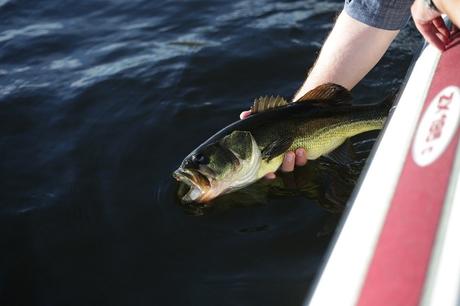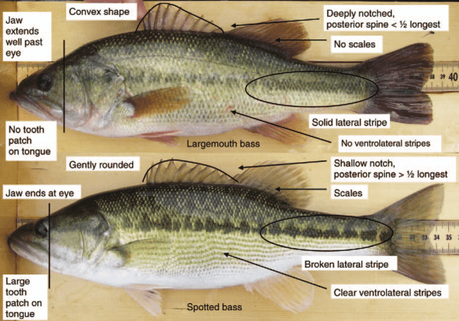
Bass are ravenous gamefish that are known for being very aggressively predatory. This aggressive behavior makes them great gamefish to go after. The two species of freshwater bass that are most common are the largemouth bass and the smallmouth bass. While remarkably similar, they are also different in many ways. An experienced angler should be able to tell the differences between largemouth vs smallmouth bass.
One difference that we can all assume is the diameter of the mouth of both species are different, but they also differ in feeding behaviors, general size, and weight. The two species differ in weight but is not uncommon to catch a large smallmouth and confuse it for a largemouth.
Because of this you must learn their differences in appearance and there are plenty of them.
In this article we will discuss largemouth vs smallmouth bass and how you can use these differences to assist you in catching them.
Common Facts About Freshwater Bass
As we stated above, freshwater bass are aggressive hunters. If you have ever seen a bass slam a topwater lure, then you know just how fast and accurate they are. Some species of other fish will strike, and you may not feel it but not bass, when a bass strikes, you will know immediately.
Topwater lures are phenomenally successful for freshwater bass because they like to utilize a “strike from beneath” tactic. Within the lake, the freshwater bass is an apex predator. Crawfish, other fish, and insects are a part of their primary diet.
When you look at largemouth vs smallmouth bass, they both love cover. Logs, weeds, and even man-made cover such as docks and bridges are typically where they like to sit. People who operate ponds stocked with bass for recreational fishing often give their bass options for cover by sinking logs or other objects for them.
Fishing for bass during their spawn is a good strategy as they often prey on hatched Perciformes, even their own species. Both species spawn in mid-spring when there starts to be a distinguishing difference in water temperature, making springtime a great time to get out there and catch them.
Bass are shimmering and easily spotted outside of their vegetation cover but can be hard to spot in shady areas or in deep cover. Polarized sunglasses make a great difference for this and we recommend that you get a pair for yourself.
Largemouth vs Smallmouth Bass – Physical Differences

Largemouth and smallmouth bass are remarkably similar in looks and the untrained eye can be confused with the other. There are a few distinguishing features that set them apart however and we will discuss them so that you know what you caught when you net it.
As the names suggest, the mouth is the first step in differentiating the two species. Largemouth bass will have a much larger diameter for a mouth than smallmouth bass.
Another facial feature that you can look for is where the jawlines of the upper jaw sit. Largemouth bass have a jaw that extends past the eyes and the smallmouth has a jaw that sits level and aligned with the eyes.
Being a member of the Perciformes means that the freshwater bass is a close cousin to the common perch. When looking at the smallmouth bass, you will see the similarities. Smallmouth bass have vertical lines patterned along their body like the perch while the largemouth has horizontal markings and the marking on the largemouth bass are typically darker in tone compared to the smallmouth.
The dorsal fins have spines in both species, but you can use these fins to differentiate the two species. Smallmouth bass have a “streamline” dorsal fin that connects the spiny dorsal to the soft dorsal further along the back of the spine. If you look at the largemouth bass, there is a clear notch that separates the spiny dorsal and the soft dorsal. The spiny dorsal for both species are usually remarkably similar but often the spines themselves are much thicker in a largemouth.
Largemouth vs Smallmouth Bass – Behavioral Differences
As far as hunting is considered, the two species have different methods and styles. While both species will strike from beneath, the largemouth bass love striking from below. Largemouth will hunt by sitting about 1 to 2 feet below the surface which is just low enough to keep cover and an element of surprise while still being close enough to the surface for a fast strike at its prey.
Smallmouth bass on the other hand tend to hunt in deeper water and often prey on smaller fish and other aquatic species. Generally, the smallmouth will prey on smaller food sources whereas the largemouth bass will have no problem going after larger prey such as crawfish and even mice swimming across the lake.
In terms of cover, both species love to be concealed. This is especially true mid-summer when the heat is at its peak. Often, the fishing is better at dawn or dusk when temperatures are low because bass will be in cover all day if it is hot.
Largemouth bass also tend to like still water and will likely be found in ponds and lakes where there is no flow. Smallmouth bass will also prefer still water environments, but the smallmouth will also inhabit running water such as rivers as well.
One thing that differentiates smallmouth bass from largemouth bass is that many anglers testify that smallmouth bass have more fight in them when reeling them in. One would think that the largemouth bass would be the heavier fighter, but it is usually the smallmouth in fact.
Tips for Catching Largemouth and Smallmouth Bass
Though there are similarities, there are differences in feeding preferences between both species. One rule of thumb is depth. As we have learned, largemouth bass prefer shallow hunting conditions which makes topwater lures a great option. Spoons, rooster-tails, and Rapala lures work as well so long as they do not dive too deep. Typically, fly fisherman enjoy catching largemouth bass because of this and are usually quite successful.
Bass are noise-driven as well and are bribed by loud lures. If the lure is going under the water you should use a rattler or a vibrating shad and if you are surface fishing, use something that will make a small splash and get their attention.
Smallmouth bass tend to hunt at deeper depths and a Rapala is a good choice. Two main things to consider are your speed at which you retrieve your lure and the vegetation you are casting near. Some lures are designed to avoid snagging on vegetation and allow you to get your lure much closer to the fish.
When fishing for smallmouth bass it is important to know that since you are fishing at depths for them, they will also go after live bait. Nightcrawlers and leeches are good choices, but they typically will not eat bait off the bottom of the lake. We recommend a weight to get the bait out to their cover and about 8 inches below that weight attach a floating head with your bait. Keep in mind that the heavier the bait, the larger floating head you will need to get it off the bottom.
Conclusion
The largemouth vs smallmouth bass discussion is all about the environment and biology. Understanding these two things will help you be successful at fishing for them.
Both are opportunistic predators and because of this, do not be surprised if you end up catching both. Though bass are typically plentiful, be sure to check your local regulations. Often there are size or weight limits on what you can keep. If you are a catch and release fisherman, largemouth and smallmouth bass fishing can give you an entire day of joy since they can often be caught all day long and it is not uncommon for a bass to get caught twice.
Bass love cover, especially during the heat of the day. Use this to your advantage and entice them out of their hiding spot by doing a drive-by with your lure.
If catching bass for consumption is your goal, then typically most anglers opt for keeping the smaller fish claiming that they taste better. But they are a perfectly healthy fish to eat and they are easy to catch.
Understanding their behavior is crucial to success and this is most important in the spring during spawn. At the end of the day, your success will be more and more guaranteed by trial and error. While their behavior is generally the same wherever you go, you will notice subtle differences depending on where you fish.
